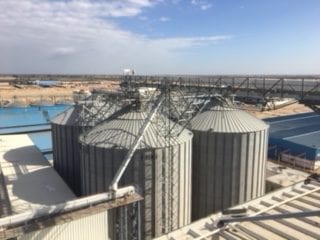Egyptian Poultry Customers Appreciate Technical Support from U.S. Soy
- Category:
- Animal Utilization
- General News

USSEC conducted industry meetings with poultry customers in Egypt from December 7 through 10.
USSEC consultant Dr. Craig Coon, professor at the University of Arkansas and poultry nutritionist at the Center of Excellence for Poultry Science, met one-on-one with nutritionist Dr. Ehab Elbendary and engineer and feed mill manager Mohamed Kashaf of Dakahlia Poultry in Sadat City, Egypt, about an hour and a half north of Cairo.
The main objective was to observe production and feed quality at Dakahlia Poultry’s new feed mill. The new feed mill became fully operational in September 2018 and is the largest capacity feed mixing facility in the Middle East, with six hammer mills going to mixer and three pellet lines manufacturing the final product. The mill was developed mainly for the purpose of producing broiler and aqua feed for Egypt’s poultry industry and can produce 600 metric tons (MT) of mixed feed per eight-hour shift with plans of producing 600,000 MT per year. The plant is currently hiring staff for the second shift.
Dakahlia Group is a substantial size poultry group with 1.8 million broiler breeders (Cobb, Aviagen and Hubbard), and the new mill has the capacity to produce adequate feed for the broilers and breeders owned by the Group for one week from the feed made from just one eight hour shift at this new mill. Dakahlia achieved a new landmark in poultry production since the opening of the new mill and utilizing the quality feed system for feeding their breeders and broilers. The Group achieved a Production Efficiency Factor (PEF) of 404 in 2018 based on broiler and breeder performance. The broilers for Dakahlia Poultry had an average reach of 2.1 kg bodyweight in 33.5 days with a 1.53 feed conversion ratio (FCR). Dakahlia Poultry also averaged obtaining 140 chicks per breeder.
A trip highlights were trucks delivering extruded full fat soybeans made from U.S. soybeans extruded locally in Egypt. The staff of Dakahlia Group gives a high rating to U.S. soybeans. Mohamed commented the reason he likes U.S. soybean meal is because the meal is dryer (11 percent moisture compared to 13 to 14 percent moisture) than local soybean meal or soybean meal from other origins. The dryness allows the feedmill manager to use more moisture and steam in the conditioner to create a better bind and pellet as the mixed feed goes through the pellet die of the pellet mill.
Dr. Coon spent December 9 with the staff of Cairo Poultry Company, which is the largest integrated poultry company in Egypt. They had many questions regarding their disease problems and nutritional issues. USSEC consultant Dr. Gary Butcher of the University of Florida helped them with their vaccination and disease issues, and Dr. Coon worked with the group on the nutritional problems. The main concerns with nutrition were based on trying to achieve optimum performance for broilers and breeders. Broilers (mainly Arbor Acres and Hubbard) are currently marketed at 31 to 33 days with 1.55 to 1.61 FCR. The main idea in Egypt is to market as quickly as possible because most disease occurs at 36 days or later. The company would like to market at 25 days with a FCR of 1.5 or lower. Dr. Coon told them the main thing that will make the bird grow as fast as possible is the amino acid density of the diet.
The company should supply adequate calories for each of the feeding phases (pre-starter, starter, grower and finisher), but the digestible amino acids may be increased to meet their goals for BW gain and improved FCR. The group had questions about many different feed additives and questions about the use of enzymes. Breeder issues they are dealing with are drops in fertility and egg production after 40 weeks. Dr. Coon recommended they might need to try to keep the male more in line on BW to maximize fertility. Egg production drops were occurring because the company is removing 1 gram of feed per week after peak and they remove approximately 50 kcal. They are using 2800 kcal ME/kg breeder feed and they feed 170 g at peak and remove feed until they are consuming approximately 11 percent less feed calories. Dr. Coon suggested because the breeder body composition is different than in the past, the breeder needs additional calories to maintain their muscle mass. Modern broiler breeder females gain muscle mass from 45 weeks to 65 weeks, which increases the maintenance calories required during the last portion of lay. The industry now only drops 6 percent of peak feed calories for breeders because of this body composition change instead of 10 to 12 percent that was reduced in the past.
The staff members mentioned that Egypt has always appreciated the support of USSEC and they value the technical seminars provided.

